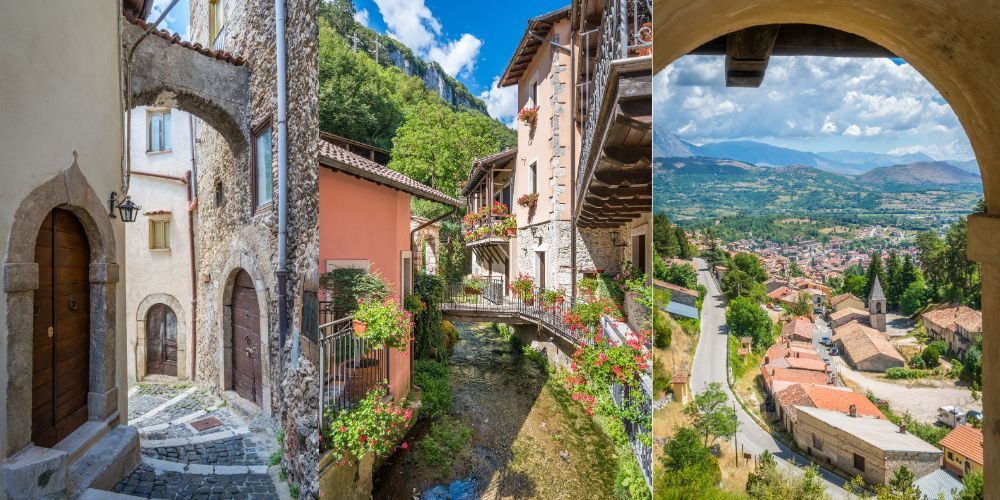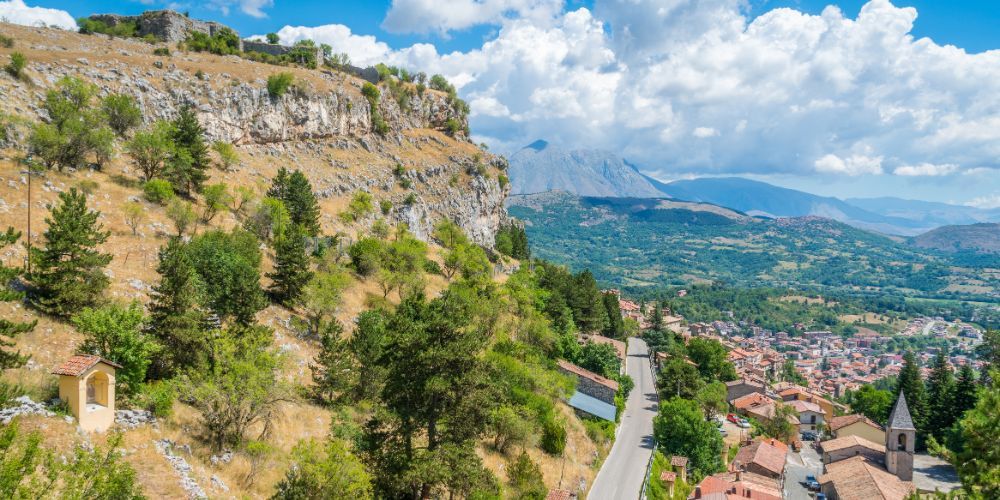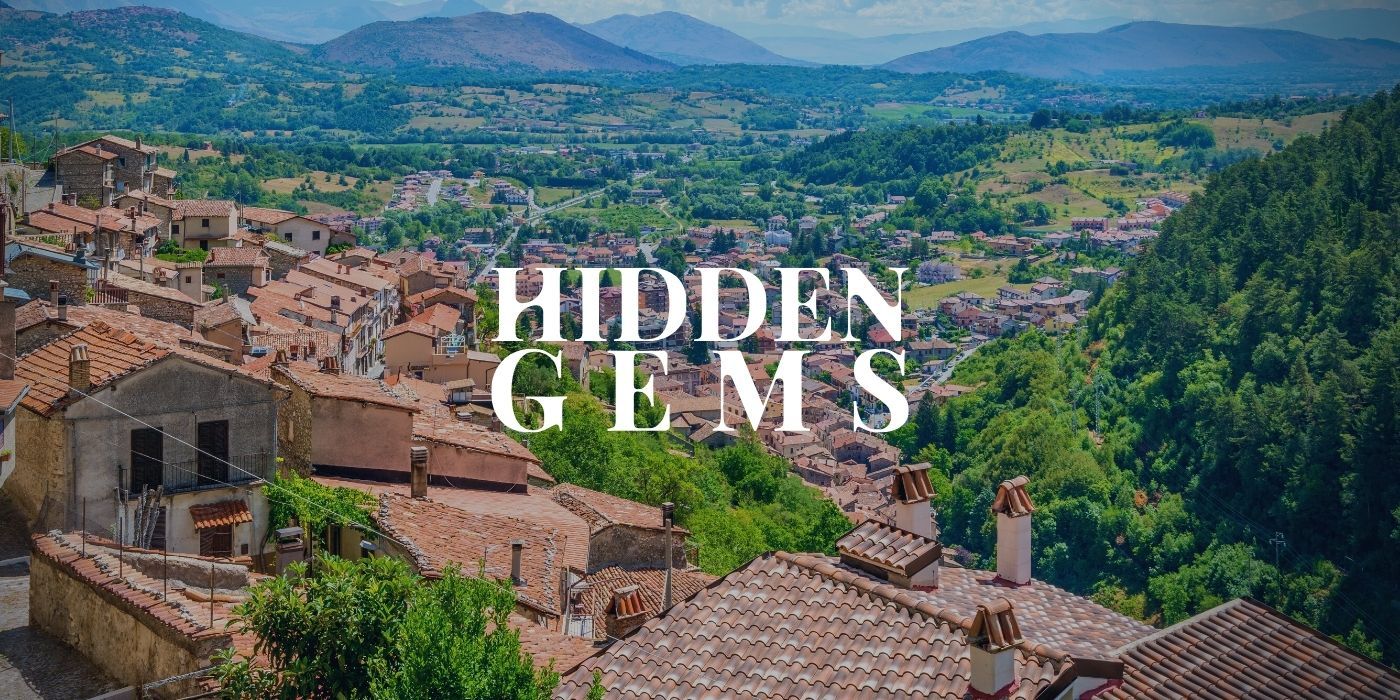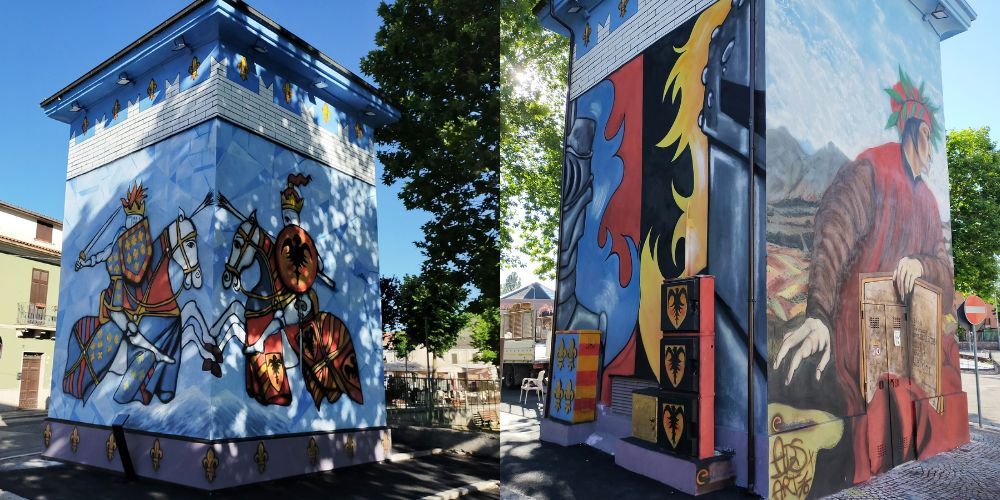“...E là da Tagliacozzo, dove senz'arme vinse il vecchio Alardo”. With this verse from Dante's Divine Comedy, included in the twenty-eighth canto of Inferno, we are preparing to travel towards a border land between Abruzzo and Lazio, in the westernmost part of the province of L'Aquila, to discover the village of Tagliacozzo.
Get ready to leave with us crossing the magnificent landscape of the Marsica highlands, which with their colors - green, brown and white depending on the seasons - frame the splendid villages of this region. We will find out where it is, how to get there and above all what to see in Tagliacozzo; read carefully until the end, there will be very interesting useful tips for you to plan your trip to Italy and we will also reveal a historical fun fact about this hidden gem!

Where is Tagliacozzo and how to get there

Before learning what to see in Tagliacozzo let's check out where it is. Tagliacozzo is a village in the province of L'Aquila, in Abruzzo, a few kilometers away from the border with Lazio. Let's see how to get there by car and train starting from the main cities of the region.
How to get from L'Aquila (and Teramo) to Tagliacozzo: take the A24 highway heading south and continue on the A25 highway near Torano; then, at the Magliano de' Marsi exit, continue on the SS5 to your destination. Moving by public transport it is necessary to take a bus to Carsoli and continue from there by train to Tagliacozzo. Even starting from the city of Teramo it will be necessary to drive on the A24 to L'Aquila and follow the same itinerary; it is not recommended to travel by public transport.
How to get from Pescara to Tagliacozzo: take the A25 highway and drive to Magliano de' Marsi, then go on following the SS5 to your destination. In this case, it is not recommended to travel by train because it would be necessary to change several trips, making the journey uncomfortable and above all much longer.
Be careful though, even though Tagliacozzo is in Abruzzo it is only an hour's far from Rome! By car you need to drive on the A24 highway until the specific exit for Tagliacozzo, following the SS5. The Capital is well connected to the village even by traveling by train, a journey of less than two hours following the same route.
Find out the best of the Capital with Visit Rome PassRemaining in Lazio, as well as from Rome it is possible to easily reach Tagliacozzo by car also starting from Viterbo, the historic city of the Popes. The route involves driving on the SS675 eastwards to Orte, continuing from here on the A1 highway to Tivoli Terme and then on the A24 highway until the specific exit for Tagliacozzo, near the Pietrasecca area. We don’t recommend traveling by public transport in this case in order to save time, which can instead be spent in visiting the beauties of the village.
Discover Viterbo with our City PassWhat to see in Tagliacozzo: let's discover the village

And here we are finally arrived in Tagliacozzo, welcomed by the beautiful landscape of Marsica and the lively and colorful atmosphere of this village rich in history, capable of conveying the authenticity of Abruzzo just with a glance. Get ready, our walking tour to discover what to see in Tagliacozzo is about to begin: a small journey through its squares, its main streets and its surroundings, in search of the same inspiration of the Supreme Poet, Dante and the most beautiful places to visit, absolutely unmissable in your travel itinerary!
The first stage to visit on the tour across Tagliacozzo is obviously the famous Piazza dell'Obelisco, well knows precisely for the presence of this monumental artistic element that’s rather unusual to find in small villages. Well, the obelisk that dominates the center of the square is actually a fountain built in 1824 to replace the ancient public pillory, peculiar above all for its artistic style which mixes the refinement of the baroque with the raw effect of the natural element, in this case the rock.
Piazza dell'Obelisco today represents the most important place in Tagliacozzo and is the most popular location for hosting events in the village. In the square it is possible to admire with pleasure many historic buildings of great value and beauty, rich in bright colors that shine especially in the sunlight, and stop for lunch or a coffee break.
Let us now move into the historic center of Tagliacozzo towards the Church-Convent dedicated to Saint Francis of Assisi, one of the most important and beautiful religious places in the village. Located in the square of Via Beato Tommaso da Celano and dating back to 1270, this church was the first stable settlement of the Franciscan community in the Tagliacozzo area.
The architectural and artistic style of the church is purely Gothic, with particular attention to the entrance portal and the rose window on the main facade of the building. The interior of the church is rather anonymous and devoid of characteristic decorative elements. On the contrary, in the innermost part of the building (which develops in a quadrangular way) there is a fascinating Renaissance-style cloister where it is possible to notice a central well and some interesting artistic decorations such as the frescoed lunettes which represent moments in the life of the Saint.
And speaking of frescoes...have you noticed the beauty of the barrel ceiling of the passageway that leads from the church to the cloister? It is a small artistic masterpiece created in 1608, perfectly preserved, which illustrates the family trees of the local families devoted to St. Francis, with relative inscriptions of the names on the faces of each member included in this characteristic representation.
Continuing a little further on, here we arrive in front of one of the most evocative historic buildings in Tagliacozzo: we are talking about Palazzo Ducale of the Orsini family, an icon of the town’s historic center and today under the protection of the Abruzzo Region.
Built already in the first half of 1300s and renovated several times over the following centuries, especially after the passage to the Colonna family, Palazzo Ducale of Tagliacozzo is a large building of approximately 4000 internal square meters divided into two floors. One of its most significant features concerns precisely the great and clear diversity between the two areas of the building: in fact, while the first floor reflects the Gothic style very much, the second is clearly created according to Renaissance taste.
In short, visiting Palazzo Ducale of Tagliacozzo is a travel experience to discover the art and architecture of other times, the most authentic visions of the world characterizing the lives of those who dwelled within these walls in the past.
Staying on the subject of interesting buildings in the historic center of Tagliacozzo, not far from Palazzo Ducale there is the elegant Teatro Talia, a majestic neoclassical style building with absolute photogenic appearance - perfect for your postcards from Tagliacozzo!
Originally built as a monastery yet in the Middle Ages, the palace was purchased by the municipality for the construction of nowadays theatre, officially inaugurated in 1832. The facade of the theatre, which stands out for its peculiar green color in contrast with the white of the architectural elements and decorations on the pediment, has three large doors, as many windows and street lamps. The internal capacity of the theater, which also includes a cinema screen, is approximately 200 seats.
A small fun fact concerns the name of the theatre, that is Talia, one of the mythological muses who, at least according to legend, dwelled along the banks of the Imele river which crosses Tagliacozzo.
Moving to the westernmost and ancient part of the historic center of Tagliacozzo we come to the Church of Santa Maria del Soccorso, for which there are certified historical sources dating back to 1115. The church is located in the hamlet of Altolaterra, a mountain cleft between the slopes of the Apennines in Abruzzo that frame the landscape of Tagliacozzo.
Renovated and enlarged several times over the centuries and in particular during the Renaissance, of which clear artistic examples can be found in the entrance portico and bell tower, the church houses on the inside some works of sacred art by Angelo Guerra d'Anagni. Seen from the outside, the Church of Santa Maria del Soccorso immediately captures attention for its aesthetics and its geographical location, offering an interesting glance with its profile in contrast with the greenery of the surrounding nature; furthermore, on the mountain that stands behind it, there are the ruins of the ancient medieval fortress of Tagliacozzo and the related church of Santa Cecilia.
Among the other churches to visit in Tagliacozzo, we suggest the Church-Monastery of Saints Cosma and Damiano, the Church of Saint Barbara, the Church of the Annunziata in Piazza Duca degli Abruzzi near the Town Hall, and above all the Sanctuary of Madonna dell'Oriente, south-east of the urban center of Tagliacozzo.
To conclude the walking tour to discover what to see in Tagliacozzo, wandering around even the most hidden alleys and crossing its ancient arches such as Porta dei Marsi, we cannot forget to stop by and say hello to Dante, the Supreme Poet who paid homage to the village mentioning it in his legendary Divine Comedy.
A statue in his honor was in fact placed in the namesake square, where is also located the town's train station. But keep reading...because our trip to Tagliacozzo doesn't end here and there is much more to discover!
What to see in Tagliacozzo and surroundings

After having explored the historic center and the main attractions in the village, let's dedicate time now to discover what to see in Tagliacozzo and surroundings to immerse yourself in the beauty of the area and make the most of your trip to Abruzzo. There are four exceptional natural areas to visit near Tagliacozzo:
- Marsia, a mountain tourist location west of Tagliacozzo characterized by beech forests that precede the Simbruini Mountains between Abruzzo and Lazio, ideal for green holidays and glamping or for a week through snow and skiing;
- Piccola Svizzera (Little Switzerland), a residential and tourist area south of Tagliacozzo at around 1000 m above sea level, famous above all for its lush nature and the presence of numerous riding stables and equestrian clubs;
- the Imele Sources Geological Park, an area south-west of Tagliacozzo characterized by an ancient nature trail that follows the Imele river from its sources near Verrecchie on the Simbruini Mountains, ideal for walks within nature;
- and Cammino dei Briganti (Bandits Path), a long walking itinerary approximately 100 km long that extends between Abruzzo and Lazio discovering suggestive natural views of the area.
Are you looking for suggestions for other beautiful villages to visit in Abruzzo? Take a look at Scanno, Villalago and Opi!
Fun fact: who was defeated at Tagliacozzo?
And here we are finally at the moment of the fun fact about Tagliacozzo, the last pearl of our journey to discover this village in Abruzzo and its relationship with Dante's Divine Comedy. The question is: who was defeated at Tagliacozzo?
The historical scenario is the battle of Tagliacozzo, fought on 23 August 1268, considered one of the most decisive in the political and military clash between the Guelphs and Ghibellines. Well, the first of the two factions, in support of the Pope's power and represented in this story by the army of Charles I of Anjou, defeated the second, instead supporting the political power of the Swabian emperors of the German house of Hohenstaufen, led by the very young King Conradin. The clash took place more precisely in the area now known as Scurcola Marsicana, east of Tagliacozzo, where it is possible to admire some beautiful commemorative murals (take a look at the picture).
An event of such importance could not be missing from Dante's famous masterpiece, for all intents and purposes an account of the history of his time as well as a work of art of poetry. However, although the Supreme Poet was a supporter of the Guelph faction, in the famous verse taken from the Inferno at the beginning of this article the victory of the Angevins, and more precisely of Charles himself, is given a bad name as it was essentially thanks to the old Érard de Vallery, his advisor, to suggest the strategy to be adopted in battle and to put it into practice firsthand, leading a surprise cavalry charge on the enemies and getting the final victory.
Did you like this historical curiosity about Tagliacozzo? Well, now you’ve really learned everything you need to know to visit this splendid village in Marsica and enjoy a fantastic holiday in Abruzzo made of history, poetry and natural beauty!
About the author
Written on 13/01/2024




Massimiliano Antonio Primi
Let’s find out what to see in Tagliacozzo, a charming village in Abruzzo only an hour far from Rome famous for a battle that inspired a Dante’s verse.